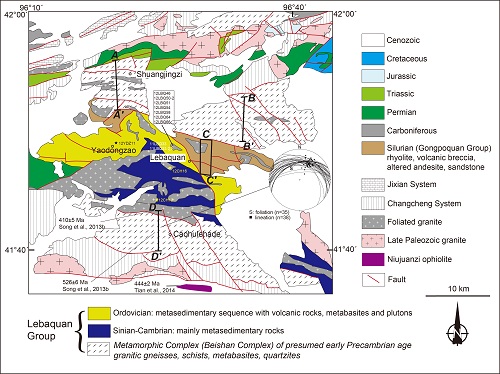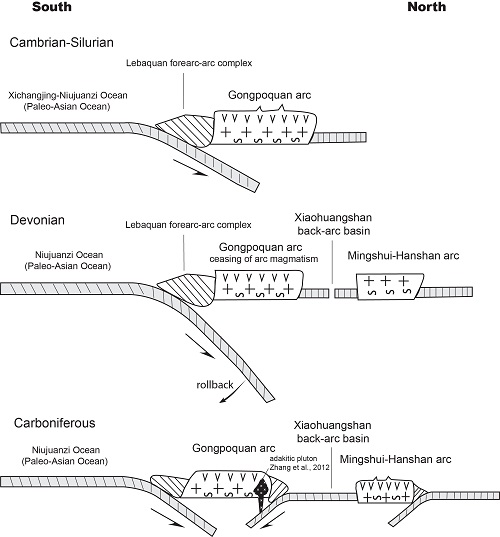|
Tectonics
|
A Paleozoic Japan-type subduction-accretion system in the Beishan orogenic collage, China
Accretionary orogenic belts are complicated collages composed of magmatic arcs, accretionary complexes, ophiolitic mélanges, fore-arc/ back-arc basins and microcontinents, which are key sites of continental growth. The Central Asian Orogenic Belt is characterized by the appearance of various kinds of magmatic arcs and associated accretionary complexes that were formed diachronously. The Beishan orogenic collage, which connects the Tianshan orogenic belt to the west and the Inner Mongolia-Solonker suture to the east, is a key area for understanding the accretionary tectonics of the southern Central Asian Orogenic Belt. The Beishan orogenic collage is viewed as being similar to the Central Tianshan terrane and the result of microcontinents that rifted from the Tarim Craton. However, the timing and tectonic attributes for metamorphic terranes from the Beishan orogenic collage is ambiguous. There is no detailed study on the metamorphic complexes and associated volcanic rock, which has hampered efforts to properly understand the architecture of the Beishan orogeny. Postdoctor Dongfang Song and his colleagues from the Tectonics Group of Tethys Research Center, Institute of Geology and Geophysics, Chinese Academy of Sciences, have carried out detailed studies from field mapping and geochronology for four cross-sections on the metamorphic complexes and volcanic rocks from the Central segment of Beishan (Fig. 1). Field mapping revealed that all the metamorphic complexes have undergone polyphase ductile deformation (Fig. 2), with mainly NNE-dipping foliations, while the volcanic rocks were weakly deformed and the primary pyroclastic structures are preserved. High-resolution geochronological data indicates that the ages of the protolith for the metamorphic complexes range from ~400 Ma to 465 Ma, but were not formed in Precambrian as previously regarded, which probably represents the deeper parts of arcs or accretionary complexes. The volcanic rocks are formed at 446-441 Ma, with Precambrian detrital zircon ages. The age information may indicate continent materials in the formation of the arcs, but it excludes the possibility of large-scale crystallized basement in this area. Combined the temporal and spatial distribution of ophiolites and fore-arc complexes in this area, Song et al. proposed that during the Paleozoic there was a Japan-type subduction-accretion system formed as a result of northward subduction of a main ocean (the Niujuanzi-Xichangjing Ocean) in the Beishan orogenic collage (Fig. 3), which resembled the Japanese accretionary orogen on the western Pacific margin. This research indicates that the Central Asian Orogenic Belt is a complicated collage composed of Japan-type subduction-accretion system, intra-oceanic subduction system and continental margin accretion system. In addition, most of the metamorphic complexes in the Central Asian Orogenic Belt are actually deeper parts of arc-accretionary complexes, but not microcontinents. This research was published recently in the international journal Lithos (Song et al. A Paleozoic Japan-type subduction-accretion system in the Beishan orogenic collage, southern Central Asian Orogenic Belt. Lithos, 2015, 224: 195-213).
Fig. 1
Fig. 2
Fig. 3 Contact: Dr. Song Dongfang |
Head of Group

Prof. Xiao WenjiaoTethyan orogenic belt and the Central Asian orogenic and mineralization Tel:86 010 82998524 Email:wj-xiao@mail.iggcas.ac.cn |
-
SIMSSecondary Ion Mass Spectrometer Laboratory
-
MC-ICPMSMultiple-collector ICPMS Laboratory
-
EM & TEMElectron Microprobe and Transmission Electron Microscope Laboratory
-
SISolid Isotope Laboratory
-
StIStable Isotope Laboratory
-
RMPARock-Mineral Preparation and Analysis
-
AAH40Ar/39Ar & (U-Th)/He Laboratory
-
EMLElectron Microscopy Laboratory
-
USCLUranium Series Chronology Laboratory
-
SASeismic Array Laboratory
-
SEELaboratory of Space Environment Exploration Laboratory
-
PGPaleomagnetism and Geochronology Laboratory
-
BioMNSFrance-China Bio-mineralization and Nano-structure Laboratory




